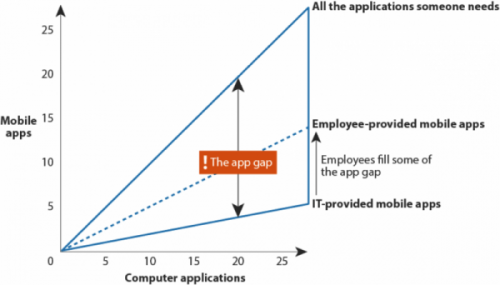Plugging The Mobile App Gap
Entrepreneurs do their best to plug the app gap when established companies can't or won't see the opportunity. That's what's driving apps like Evernote, Dropbox, Flipboard, Uber, RoamBI, TripIt, and Expensify.
At home, the app gap might lead to a disruption in your market. If you're not serving your customer on a mobile device, maybe a digital disrupter will. (Yes, I know many Web designers are busily adapting some of the almost 400 million sites to work great on mobile devices. It hasn't plugged the app gap yet.)
In business, the app gap is challenging because employees are happy to plug the app gap at work themselves. That's why they bring their own apps. Here's what it looks like:
Figure 1 Employees Happily Plug The App Gap Themselves

To plug the app gap at work, IT has to take a hard look at which employees need which apps and why. See our recent report for Forrester clients with all the data and analysis here.) In our Forrsights surveys of how employees use technology at work, we have identified two major segments of employees that need mobile apps for very different reasons:
- Mobile professionals need productivity apps to be efficient from anywhere. For example, the rise of Dropbox at work signals just how important files on any device are to mobile professionals. Mobile professionals want to do everything on a tablet and many things on a smartphone. They are great at plugging the app gap themselves. This is the BYO app gap solution that IT is most frantic about. Take heart: Employees will show you what apps they need. Business owners will help you fund them.
- Mobile practitioners need process apps to be effective in the moment. In a typical example, a sales organization buys 1,000 tablets and moves to Google Apps and Salesforce.com and Box to support the selling process. Or the head of field operations funds Samsung Galaxy Notes and apps to improve the field service process. Often the process owner — sales, field service, maintenance, etc. — will pay to close this app gap.
In both cases, the business outcome is valuable enough that business budget holders often fund the mobile app. What about you? Where are you seeing an app gap? How are you plugging it?
